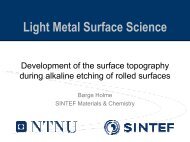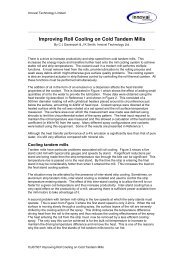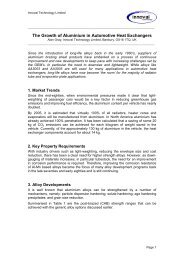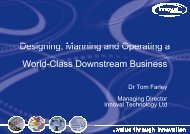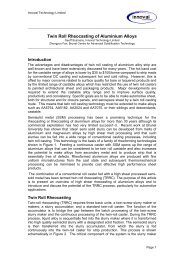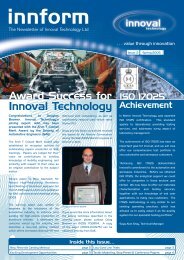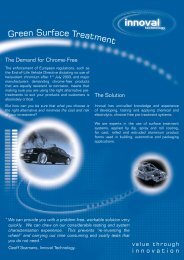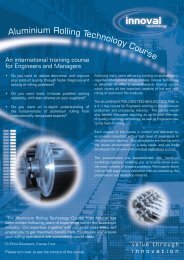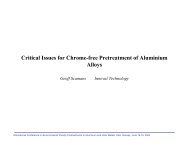Pretreatment of Aluminium â An Overview - Innoval Technology Ltd
Pretreatment of Aluminium â An Overview - Innoval Technology Ltd
Pretreatment of Aluminium â An Overview - Innoval Technology Ltd
You also want an ePaper? Increase the reach of your titles
YUMPU automatically turns print PDFs into web optimized ePapers that Google loves.
<strong>Innoval</strong> <strong>Technology</strong> Limited<br />
There are three general approaches to cleaning<br />
Alkaline spray or immersion<br />
Acid spray or immersion<br />
Acid electrolytic cleaning<br />
<strong>Pretreatment</strong><br />
The pretreatment process is <strong>of</strong>ten integrated with a preceding strip cleaning process,<br />
and usually a subsequent coating process.<br />
<strong>An</strong> exception is the provision <strong>of</strong> pretreated-only coil which is cut into sheets for the<br />
packaging industry (e.g. food cans, metal closures) where the individual sheets are<br />
lacquered and printed on sheet coating lines. This is because it is not practical to<br />
print or decorate coils due to the wide range <strong>of</strong> designs required, and the relatively<br />
small runs per design.<br />
Pretreated-only strip is coated with 5 to 10 mg/m2 dioctyl sebacate (DOS) to ensure<br />
the cut sheets destack and feed smoothly into the sheet coater/decorators.<br />
The pretreatment can be either a chemical or an electrolytic process, to replace the<br />
natural oxide film. The chemical process is more usual, with different versions for<br />
food packaging applications (to satisfy regulations) and for architectural or transport<br />
applications.<br />
Historically pretreatments for coil coated aluminium were chromium VI based<br />
formulations which provided excellent performance.<br />
Theses chromate conversion coatings relied on a film forming mechanism based on<br />
acidified chromate with fluoride providing a source <strong>of</strong> CrVI ions which were released<br />
in service giving a “self-healing” mechanism in defect/damaged areas.<br />
Formulations based on CrVI are still used for architectural applications while CrIII<br />
systems have been developed for food contact products.<br />
The most commonly used pre-treatment for coil coating is a thin chromate film (~ 200<br />
nm) which provides both good adhesion and corrosion protection.<br />
Solutions can be chromate (yellow chromating) or chromate-phosphate (green<br />
chromating) and can be applied by immersion, spray or chemcoater (no-rinse).<br />
However, as chromium(VI) is toxic, there has been a considerable amount <strong>of</strong> effort to<br />
develop more environmentally friendly alternative pre-treatment systems.<br />
Current alternatives include:<br />
Metal ion analogues to Cr(VI) (Mn, Co) and inorganic molecules reacting with<br />
oxidised Al to form mixed oxides (Ti, Zr)<br />
Inorganic film-forming oxides which cover the surface and promote adhesion<br />
(silicates, molybdates, vanadates)<br />
Organic polymers with high complexing capacity.<br />
In excess <strong>of</strong> 50% <strong>of</strong> global packaging products and 25% <strong>of</strong> European architectural<br />
products use Cr-free pretreatment systems.




